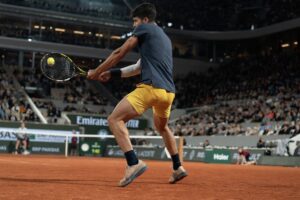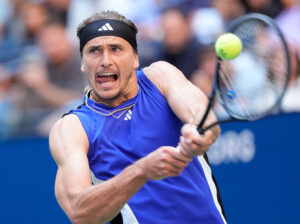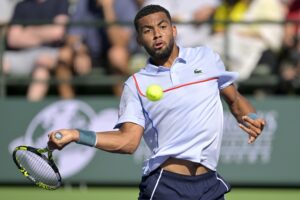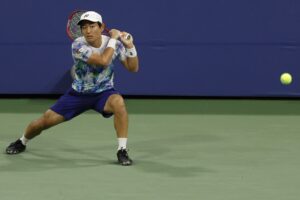Countdown to Roland Garros: In the fourth and final part of our series building up to the French Open, Last Word on Tennis looks at the greatest French Open Men’s Champions.
If the identity of the greatest ever French Open Men’s Champion is no surprise (clue: given his return to form this year, he has every chance of winning an astonishing tenth title at Roland Garros), the identity of the four other greatest male players at the French Open is far less obvious. Suffice it to say that between them, the other four men on this list span almost the entire history of the tournament, from its earliest days to the recent past.
Here are the five finest French Open Men’s Champions.
- IVAN LENDL (Winner of three French Opens: 1984, 1986, and 1987)
There are several three-time winners at Roland Garros, including the brilliant Brazilian, Gustavo Kuerten, and the superb Swedish champion, Mats Wilander. However, of all the three-time winners, Ivan Lendl just merits inclusion ahead of Wilander, for the simple reason that he also reached three other French Open finals, whereas Wilander was runner-up “only” twice. In truth, though, bare statistics alone do not do justice to the domination that Ivan Lendl enjoyed at the tournament in the mid to late 1980s.
Lendl bestrode several eras in men’s tennis, after initially emerging at the tail-end of the Borg-McEnroe-Connors era. Having been a junior champion in Paris in 1978, Lendl reached his first French Open final (indeed, his first Grand Slam final anywhere) in 1981, when he narrowly lost a fine five-setter to Borg, in what would turn out to be the great Swede’s final Grand Slam victory. Lendl pushed him close for the first four sets before finally showing his inexperience and capitulating 6-1 in the final set. Of course, that was to be the first of four Grand Slam finals that Lendl would lose before finally claiming his first Major, an unwanted record that he shared with Andy Murray and one that perhaps lies at the heart of their unlikely relationship as player and coach.
Lendl finally won his first Grand Slam title in utterly unexpected and incredibly thrilling fashion when he won another five-setter against John McEnroe in Paris in 1984. The tennis that McEnroe played for the first two sets that year, which he won relatively easily 6-3 and 6-2, is probably the finest tennis that any pure serve-volleyer has ever played on clay. Indeed, even after Lendl rallied to win the third set, McEnroe still went on to lead 4-2 in the fourth and seemed set to triumph. However, Lendl showed all the fighting spirit that he had hitherto been suspected of lacking to cling on amid McEnroe’s barrage of lefty serves and deft volleys, and eventually won through 7-5 in the fifth.
Lendl had laid down a marker for the next great era of men’s tennis – that of the mid to late 1980s, which included the finest periods of their career of both Boris Becker and Stefan Edberg. Although Lendl lost the 1985 French final in four sets to Mats Wilander, he recovered sufficiently to win the next two editions of the tournament, beating yet another talented Swede, Mikael Pernfors, in straight sets in 1986 and then gaining his revenge on Wilander in 1987. The only surprising thing, given his dominance of the men’s game at this time (with the notable exception of Wimbledon, which he never won), is that Lendl did not add to his treble of French Open titles, with perhaps his most surprising – indeed, embarrassing – defeat coming in 1989. That year, Michael Chang went on his own miraculous run at Roland Garros and finally cracked the seemingly uncrackable Czech by serving under-arm in the fifth set of their fourth round match.
Lendl would never wholly recover from that ignominy in Paris and indeed he only ever won one more Grand Slam title (the Australian Open in 1990) as his own period at the top of men’s tennis inevitably came to an end. While it lasted, though, he was one of the greatest men’s champions and, as John McEnroe often points out, probably the fittest man ever to have played the game up to that point.
- RENÉ LACOSTE (Winner of three French Opens: 1925, 1927, and 1929)
It is entirely appropriate that two of the four “Musquetaires,” who, along with Suzanne Lenglen, did so much to establish French tennis in the 1920s, make this list. The only surprise is that the most celebrated of the Musquetaires, René Lacoste, comes only fourth on the list, behind his less famous counterpart, Henri Cochet.
Like Ivan Lendl, Lacoste won a hat-trick of French Open titles and reached the final on three other occasions. Indeed, just as Lendl largely dominated the men’s tournament at Roland Garros in the 1980s, so Lacoste imposed his own distinct signature on it six decades earlier. Lacoste first made the final in 1924, losing to yet another of the Musquetaires, Jean Borotra, in five fairly close sets (with the exception of the third set, which Lacoste ran away with to “bagel” Borotra 6-0). He gained his revenge on Borotra the following year, when he won his first French title, only to lose the final again the following year, this time to Cochet. And still he was only halfway through his remarkable run of reaching six successive finals at Roland Garros, a record that has not been matched by any male or female player ever since.
Lacoste’s most famous French Open win was in 1927, when he defeated “Big” Bill Tilden, the US superstar of his day, in what was arguably the greatest ever French Open final in either the men’s or women’s events. By finally overcoming a man who at the time was thought to be virtually unbeatable, Lacoste not only claimed his second French Open title but in the process shattered the aura of invincibility that had enveloped Tilden in particular and US tennis in general in the period between the wars. As a result, Lacoste and his fellow members of the original “Fab Four” (or at least, the “Fabuleux Quatre”) were able to defeat Tilden and the other members of the previously all-conquering US Davis Cup team in Philadelphia later that year, which was to be the first of six successive Davis Cup wins.
Lacoste maintained his extraordinary record of winning in Paris one year and then losing the final the next year for the following two years, first falling to Cochet again in the 1928 final before winning his third and final French title in 1929, when, as in 1925, he beat Borotra. Whereas the 1925 final had been relatively straightforward, with Lacoste winning in straight sets, the 1929 edition was a classic contest, with Lacoste finally winning 8-6 in the fifth. Intriguingly, he also won the third set of that final 6-0, meaning that twice in finals in the 1920s he had “bagelled” two of his compatriots, which some French tennis writers still cite as evidence as to why he, at his very best, was the greatest and certainly the most stylish of the four great Frenchmen of the period.
- HENRI COCHET (Winner of five French Opens: 1922, 1926, 1928, 1930, and 1932)
René Lacoste may have been thought by most observers (especially most French observers) to have edged the other Musquetaires aesthetically, but statistically the greatest French Open champion of the four was Henri Cochet, who won a remarkable five of the six Roland Garros finals that he reached.
The stories of the four Musquetaires, like those of the original Three Musketeers of the Alexandre Dumas novel, are so intertwined as to be almost inseparable. Of course, they were inseparable in their six successive Davis Cup triumphs from 1927 to 1932, but even in the Men’s Singles event in Paris they all faced each other so many times, including in finals, that it was almost impossible to think of them as individual players, as opposed to component parts of the same four-man team. Nevertheless, of the four it was Cochet who achieved the greatest success at his home Grand Slam, winning five titles in a 10-year period and defeating Lacoste in two finals.
Perhaps one reason why Cochet is less celebrated than Lacoste is the fact that he never won a truly great final in Paris. He won all five of his successful finals within four sets, and probably his finest French triumph of all, against Bill Tilden in 1930, was still overshadowed by the fact that it could not bear comparison with Lacoste’s glorious vanquishing of the same opponent three years earlier. However, even if Cochet has not quite entered the popular sporting imagination in the same way as Lacoste, the fact that he ultimately won more French titles than Lacoste (five to Lacoste’s three) and more Majors in total (eight to Lacoste’s seven) must have been considerable consolation.
- BJORN BORG (Winner of six French Opens: 1974, 1975, 1978, 1979, 1980, and 1981)
And so we come to the top deux men’s French Open champions. Whereas the French domination of their own tournament in the 1920s and early 1930s was very much a collective effort, with Cochet, Lacoste, and Borotra virtually trading tournament wins for more than a decade, the two other outstanding periods of domination in Paris were very much one-man shows.
The first of them was that of Bjorn Borg in the 1970s and early 1980s. At least in the Anglophone tennis world, Borg is seen as being so synonymous with Wimbledon, which he won five times in a row between 1976 and 1980, that it seems almost counter-intuitive to think of him as a clay court player at all, let alone one of the very greatest clay court players. In reality, however, Borg’s period of in Paris both predated and outlasted his greatness on the grass of London, SW19.
Borg was a one-off in so many respects, not least in his playing style. He was certainly not a serve-volleyer, but nor was he a pure baseliner, unlike so many great French men’s champions (including, of course, the only man who tops him in this list). Instead, he was truly an all-court player, who could occasionally rush the net when he needed to at Wimbledon, especially in his last couple of finals against John McEnroe, but could equally hang back and trade groundstrokes on the often stiflingly slow clay of Paris.
The roll-call of players that Borg beat in his six successful French Open finals is not the greatest cast list ever assembled in tennis, with only Guillermo Villas (who he beat in the 1975 final) and Ivan Lendl (who he beat in his last Paris final in 1981) deserving to be counted as fellow all-time greats. Nevertheless, the Swedish “Iceman” wore down everyone and everything that came at him in Paris for nearly a decade, including four wins on the trot from 1978 to 1981, and for that he fully deserves to be considered as one of the greatest ever men’s champions in Paris.
- RAFAEL NADAL (Winner of nine French Opens: 2005, 2006, 2007, 2008, 2010, 2011, 2012, 2013, and 2014)
That Rafael Nadal is the greatest French Open men’s champion ever is indisputable. The only argument surrounding his status as a clay-court great is whether his dominance on the surface is so complete that it has actually hampered his all-around development as a player.
The statistics alone, staggering as they are, do not do justice to Nadal’s annexation of Roland Garros over the last dozen years. Perhaps the single most remarkable tribute to his greatness on clay is that Roger Federer has only ever triumphed once in Paris, and that after Nadal was defeated by someone else (Robin Soderling, in 2009). Federer, by common consent the greatest male tennis player ever, has often been reduced by Nadal and his booming forehand to the status of a novice taking his first steps on the surface. That’s how great Nadal has been on clay.
However, so great has Nadal been on clay that it does prompt the question: has his clay-court dominance been at the expense of the development of his all-around game? Nadal’s achievements as a multiple Major winner (he is currently joint second with Pete Sampras on the all-time list for men on 14, four behind Federer’s total) are undoubted, but it is none the less a curious anomaly that no other multiple Major winner has won so many of their titles at just one Grand Slam event. Most other multiple Major winners have shared their greatness around, as it were. Federer, for example, may have won only one French Open, but he has won seven Wimbledons and five titles in both New York and Melbourne, firmly establishing his status as undoubtedly the greatest grass/hardcourt player (or to put it another way, the greatest attacking player) in the history of tennis.
Of course, there is another way to look at it, which is this. Given how utterly perfect Nadal’s game is for clay, the real wonder is that he has won so many other Grand Slams (five in total: two each at Wimbledon and the US Open, and one in Melbourne) on other surfaces, rather than so few.
Rather like Federer, this year Nadal has been back to his imperious best. After his devastating loss to Federer in Melbourne this year (his first loss to the Swiss in a Grand Slam final in nearly a decade), he recovered magnificently, especially after returning to his beloved clay in Europe. He was unbeaten in 17 matches on the “red stuff”, taking him to his 10th titles in both Monte Carlo and Barcelona, and to another title in Madrid, before finally losing to Dominic Thiem in Rome.
Thiem, who is at the forefront of the new clay court specialists threatening the established greats of the last decade, is among the many contenders for the French title this year. However, like Federer, Djokovic, Wawrinka, and everyone else, he knows that he will probably have to go through Nadal again to do it. Nadal is not just wall-like in his ability to get balls back but in his sheer indomitability, especially on clay. Those qualities may yet take him to his tenth title at Roland Garros this year. If he does achieve that remarkable landmark, then, like so many records set by himself, Federer and Djokovic in this greatest of all eras in men’s tennis, it may be a record that is never beaten.
Enjoy articles looking back at all-time best players and tennis history in general? Make sure to check out our page devoted to stories appreciating historic achievements in tennis.
Main Photo:






